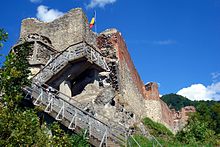| Muntenia | |
 | |
Location  | |
| State | Romania |
|---|---|
Muntenia is a region of the Romania.
To know
Territories and tourist destinations
Muntenia montana - It consists of the upper part of the districts of Argeș (chief town Pitești), Buzău (chief town Buzău), Dâmbovița (chief town Târgoviște) is Prahova (chief town Ploiești). Much appreciated by tourists are the valleys that affect the southern Carpathians. Along the valley of the Prahova River stand famous holiday resorts among which it stands out Sinaia with its royal castle.
Urban centers
- 1 Bucharest - Main city of the territory as well as state capital.
- 2 Curtea de Argeş - First capital of the principality of Romania with a series of outstanding monuments including the monastery where some voivodes of the sixteenth century and rulers of Romania of the nineteenth and twentieth centuries are buried.
- 3 Campina - A former customs post on the way to Transylvania with modest attractions such as the small castle "Iulia Hasdeu" built by the philologist and academic Bogdan Petriceicu Hasdeu in memory of his daughter who died at 18.
- 4 Câmpulung - Medieval capital of the principality of Wallachia, Câmpulung occupies the site of an unidentified Roman colony. is a popular health resort in the valley of the Râul Târgului, a tributary of the Arges.
- 5 Giurgiu - City on the left bank of the Danube, opposite the city Bulgarian of Ruse, Giurgiu it is a transport hub on the railway Sofia-Bucharest which runs on the Friendship bridge, more than two km long.
- 6 Pitești - Known as the "city of tulips" where every year in April there is a party with a flower show.
- 7 Ploiești - Cities whose fortunes and defeats have always been linked to oil.
- 8 Slănic - Thermal center thanks to the presence of three salt lakes which in the past have fueled a lucrative trade in rock salt. The old salt pan has been transformed into a tourist attraction.
- 9 Târgoviște - Historic town, Târgoviște was the capital of the principality of Wallachia until 1659, when Constantin II Brâncoveanu moved his residence to Bucharest. Târgoviște it is famous for the building, now transformed into a museum of communism, which was the scene of the brief trial of the Ceaușescu spouses followed by their execution in December 1989. The bullet holes are still visible on the courtyard wall.
Other destinations
- 1 Arefu - Traditional village with campsites and agritourism, crossed by the DN7C national road, also known as Drumul Transfăgărășan, which winds through the woods and narrow valleys of the Făgăraș Mountains of high scenic interest.
- 2 Bușteni - Renowned summer and winter resort in the Prahova Valley, a short distance from Sinaia.
- 3 Vidraru Lake (Lacul Vidraru) - Artificial lake created in 1965 on the Arges river for the production of hydroelectric energy. Extreme sports such as bungee jumping can be practiced on the lake. A few hundred meters from the dam, tourists can go to the Casa Argeseana and the pier where they can rent boats and practice pleasure boating.
- 4 Sinaia - The most famous center of the Prahova Valley with a royal castle and other interesting monuments, as well as the possibility of excursions to the Bucegi mountains.
- 5 Snagov - Town on the shores of an idyllic lake, Snagov is a traditional weekend hiking destination of the inhabitants of Bucharest.
- 6 Buzău mud volcanoes - Nature reserve dotted with small geological structures a few meters high in the shape of a volcano that erupt mud and natural gas.
How to get
How to get around
What see

Fortress of Poenari

Nămăești Monastery
- 1 Fortress of Poenari (Cetatea Poenari). Situated on the top of a hill overlooking a bend in the Argeş River, it is a ruined 13th-century fortress restored and enlarged by Vlad III of Wallachia, the historical figure who inspired the writer Bram Stoker to write his famous novel of the 1897 entitled Dracula. The ruins are accessible via a flight of 1,480 steps.
- 2 Nămăești Monastery (Mănăstirea Nămăești). Located 5 km northeast of Câmpulung, Nămăiești Monastery is reputed to be the oldest monastery in Wallachia. The monastery church is located in a cave, where, according to legend, the apostle Andrew slept one night.
Itineraries
- Transfăgărășan - Alpine road starting in Bascov, on the outskirts of Pitești and ends in the Sibiu district. It is so called because it crosses the Făgăraș Mountains, a chain of the Southern Carpathians.
